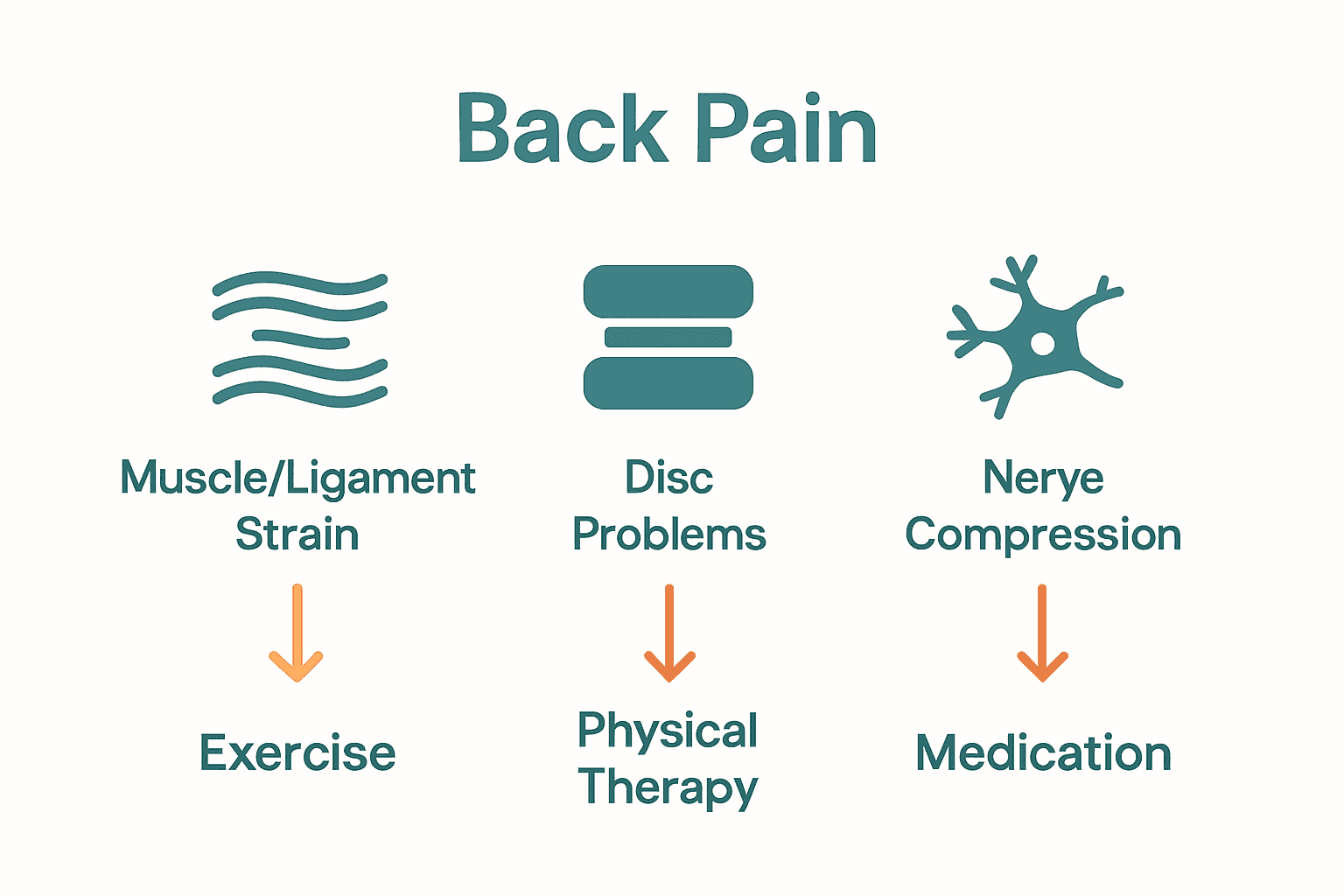Why Back Pain Happens: Complete Guide for 2025
- Dr Nathan Bridger

- 4 days ago
- 7 min read

Did you know that four out of five adults will experience back pain at some point in their lives? Back pain is not only widespread but also often misunderstood, leading many people to treat it the wrong way or ignore its real causes. Misconceptions can delay healing and make simple problems worse. Gaining a better understanding of the real facts about back pain can help you make smarter choices for relief, recovery, and long-term health.
Table of Contents
Key Takeaways
Defining Back Pain and Common Misconceptions
Back pain is far more complex than most people understand. It’s a multifaceted condition that affects millions of active individuals, from weekend warriors to professional athletes, and understanding its true nature is the first step towards effective management and recovery.
Contrary to popular belief, back pain isn’t always the result of a single dramatic injury or heavy lifting. According to healthdirect, low back pain can stem from various causes, including muscle strain, disc issues, and nerve problems. Many people mistakenly assume that complete bed rest is the optimal treatment, when in fact, staying active is often more beneficial for recovery and long-term spine health.
Research highlights several critical misconceptions about back pain. PMC research reveals that many individuals incorrectly believe back pain always originates from specific injuries or intense physical activities. The reality is more nuanced: back pain can emerge without a clear traumatic event, and diagnostic imaging doesn’t always pinpoint the exact source of discomfort.
Key misconceptions about back pain include:
Back pain only happens to older people
Imaging tests will always reveal the exact cause
Rest is the best treatment for back pain
All back pain requires medical intervention
Understanding these myths helps individuals approach back pain more effectively, recognising that it’s a complex condition requiring personalised assessment and management. Get Relief from Back Pain | Preventing Back Injuries can provide more insights into navigating this common health challenge.
Types of Back Pain and Key Differences
Back pain isn’t a one-size-fits-all condition. Understanding the different types and classifications can help individuals and healthcare professionals develop more targeted and effective treatment strategies for managing discomfort and promoting recovery.
According to painhealth, back pain can be broadly categorised into two primary types: specific and non-specific back pain. Specific back pain is relatively rare and directly linked to identifiable medical conditions such as fractures, infections, or structural abnormalities. Non-specific back pain, which represents the majority of cases, lacks a clear pathological cause and often stems from muscle strain, ligament tension, or general lifestyle factors.
Another critical classification method focuses on duration. Ausmed highlights three distinct stages of back pain based on how long symptoms persist:
Acute back pain: Lasts less than six weeks
Subacute back pain: Occurs between six to twelve weeks
Chronic back pain: Continues beyond twelve weeks
Each type of back pain requires a nuanced approach. Acute pain might respond well to very brief rest and then a gentle movement reintegration approach, while chronic pain often demands a more comprehensive management strategy involving physical therapy, lifestyle modifications, and potentially medical interventions. Understanding these distinctions helps patients and practitioners develop more personalised and effective treatment plans.

Here’s a summary of different types of back pain for quick reference:
The complexity of back pain underscores the importance of professional assessment. Get Relief from Back Pain | Preventing Back Injuries can help you navigate these different pain types and develop a targeted approach to your specific condition.
Major Causes: Muscular, Disc, and Nerve Issues
Back pain emerges from a complex interplay of different bodily systems, with muscular, disc, and nerve issues representing the primary sources of discomfort for many individuals. Understanding these mechanisms is crucial for effective prevention and treatment.
According to Medical News Today, back pain can result from multiple interconnected factors. Muscle and ligament strain often occurs through activities like heavy lifting, sudden movements, or maintaining poor posture. These strains can cause microscopic tears in muscle fibres, leading to inflammation and pain that can significantly impact daily functioning.
Healthdirect highlights three key physiological sources of back pain:
Muscle and ligament issues: Caused by overexertion, improper lifting
Disc problems: Including degeneration and potential ruptures
Nerve compression: Resulting from structural changes or inflammation
Disc-related issues are particularly complex.

Conditions like bulging or herniated discs can create significant nerve compression, leading to radiating pain and reduced mobility. Disc Injuries require specialised assessment to understand the underlying mechanisms and develop targeted treatment strategies. Importantly, these issues don’t just affect older individuals – poor biomechanics, repetitive strain, and lifestyle factors can contribute to disc problems at any age.
Lifestyle, Occupation, and Sports Risk Factors
Back pain doesn’t discriminate. It can impact anyone, from tradies and athletes to office workers and weekend warriors, making it crucial to understand how lifestyle and professional demands contribute to spinal health risks.
According to Chiro Australia, certain occupational groups face significantly higher back pain risks. Physical workers engaged in repetitive lifting, prolonged standing, or frequent bending are particularly vulnerable. This includes tradies, warehouse workers, healthcare professionals, and construction workers who repeatedly stress their musculoskeletal system throughout their workday.
Medical News Today identifies several critical risk factors that extend beyond physical occupation:
Low physical fitness: Weakened core and back muscles
Obesity: Increased spinal load and stress
Prolonged sitting: Common in office and remote work environments
High stress levels: Muscular tension and poor movement patterns
Sports and recreational activities present unique challenges. High-impact sports like weightlifting, rugby, and CrossFit demand exceptional spinal resilience, while repetitive sports such as cycling or rowing can create muscular imbalances that increase back injury risk. Get Relief from Back Pain | Preventing Back Injuries offers targeted strategies for athletes and active individuals to mitigate these risks and maintain optimal spinal health.
Prevention, Recovery, and When to Seek Help
Preventing back pain requires a proactive, holistic approach that combines smart lifestyle choices, targeted exercises, and understanding your body’s unique signals and limitations.
Healthdirect emphasises that prevention starts with fundamental lifestyle strategies. Regular exercise, maintaining a healthy body weight, and practicing good posture are critical foundations for spinal health. This means incorporating core-strengthening activities, avoiding prolonged static positions, and being mindful of how you move and support your body throughout daily activities.
Ausmed recommends several key recovery and management strategies:
Stay consistently active, even during recovery
Use targeted pain relief techniques
Consult healthcare professionals early
Implement gradual, progressive movement
Knowing when to seek professional help is crucial. Warning signs that require immediate medical attention include:
Persistent pain lasting more than six weeks
Radiating pain down legs
Weakness or numbness in lower extremities
Pain accompanied by fever or unexplained weight loss
Severe pain preventing normal daily activities
Get Relief from Back Pain | Preventing Back Injuries offers personalised assessment to help you navigate these critical decisions, ensuring you receive targeted care precisely when you need it most.
Take Control of Your Back Pain and Reclaim Your Life
Understanding why back pain happens is just the first step towards lasting relief and improved movement. The article highlights how complex and varied back pain can be including issues like muscular strain, disc problems, and nerve compression. Feeling stuck with ongoing pain or unsure about the best way to move forward is frustrating. If you relate to these challenges and want to move beyond temporary fixes, it’s time to make your recovery a priority.

At North Fremantle Chiropractic, we specialise in hands-on, movement-based care designed for people just like you. Whether you are a weekend warrior, a parent balancing busy life and exercise, or chasing peak performance we combine expert chiropractic treatment with practical strength and conditioning. Our approach does more than mask pain it builds resilience so you can confidently return to what you love without fear.
Don’t wait until back pain controls your days. Visit Get Relief From Back Pain | Preventing Back Injuries to learn how we customise care around your specific needs. Take the first step today and explore effective management strategies with us at North Fremantle Chiropractic. Your back deserves expert attention that keeps you moving forward.
Frequently Asked Questions
What are the common causes of back pain?
Back pain can stem from various sources including muscular strain, disc issues, and nerve problems. Activities such as heavy lifting, poor posture, and physical inactivity can also contribute to back pain.
What are the different types of back pain?
Back pain can be categorised into specific and non-specific types. Specific back pain is linked to identifiable medical conditions, while non-specific back pain lacks a clear cause and is more common. Additionally, back pain can be classified by duration as acute, subacute, or chronic.
How can I prevent back pain in daily life?
Preventing back pain involves incorporating regular exercise, maintaining good posture, and using proper lifting techniques. Maintaining a healthy weight and being physically active can also help strengthen the back and core muscles.
When should I seek professional help for back pain?
You should seek professional help if you experience persistent pain lasting more than six weeks, radiating pain down your legs, weakness or numbness in your extremities, or severe pain that interferes with daily activities.
Recommended


Comments